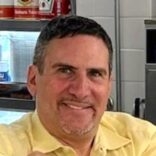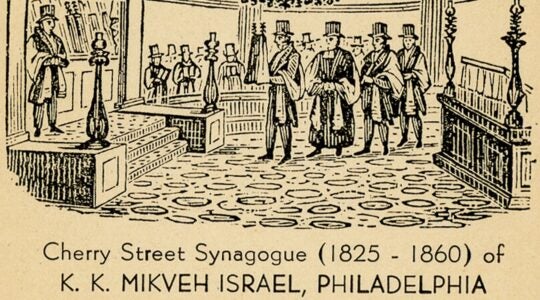Scrrttch. That was a dreaded sound in my Long Island home. It meant that the phonograph needle had dragged sideways across a record rather than staying in its neat concentric groove, permanently defiling the music that was almost sacred in my secular Jewish household. For it was through the magic of LPs that I was introduced to the original cast recordings of Leonard Bernstein’s “West Side Story,” Alan Jay Lerner and Frederick Loewe’s “My Fair Lady,” Richard Rodgers and Oscar Hammerstein’s “Oklahoma!” and many other classic musicals by Jewish composers and lyricists.
How does Jewish music figure into the sustenance of Jewish identity? I’ve been pondering this question since last month, when, during a trip to Warsaw, I caught a traveling exhibition on Jewish music at the POLIN Museum of the History of Polish Jews. “Jukebox/Jewkbox! A Jewish Century on Shellac and Vinyl,” chronicles what the museum’s director, Darius Stola, has called the “vinyl Noah’s Ark” that has preserved the musical history of 20th-century Jews, beginning in 1904 with the founding of the first record label in Poland, Syrena Record.
At a time when more than a third of Warsaw’s population was Jewish, Syrena’s founder, Julius Feigenbaum, sold recordings of Yiddish operettas, cantorial music, synagogue choirs, cabaret singers, comedy routines, film scores and tangos by Jewish composers. Indeed, “Syrena Songs,” a 2016 BBC Radio 4 program about the pioneering company, explains how a diverse group of Jewish musicians created Warsaw’s thriving pre-WWII entertainment culture, which the podcast suggests was more vibrant even than New York’s.
“Jukebox/Jewkbox,” curated by Hanno Loewy, the director of the Jewish Museum Hohenems in Austria, where the exhibit originated, has traveled for two years throughout Europe. It displays a plethora of album covers, along with music disks, gramophone machines and sheet music. Viewing these objects and listening to samples of the music at the listening stations installed in the museum, I recalled a similar exhibit that I caught in 2009 at the Contemporary Jewish Museum in San Francisco, “Jews and Vinyl,” that was curated by Roger Bennett and Josh Kun. (The same exhibit came a couple of years later to the Yeshiva University Museum in New York.)
In 2014, more than nine million vinyl records were sold in the U.S., a 260 percent increase in five years, as listeners gravitated to its perceived warmer and more realistic sound, as compared to digital formats.
For “Jews and Vinyl,” Bennett and Kun scavenged LPs from second-hand record stories, flea markets, thrift shops and synagogue rummage sales. They were searching not just for the music itself, but for the colorful, vibrant album covers that adorned the recordings of Yiddish lullabies, black-Jewish and Latino/a-Jewish pop songs, Catskills “mambo wizards,” Barbra Streisand or Neil Diamond chart-toppers and Israeli folk songs.
Bennett and Kun reprinted hundreds of these covers in their 2008 book, “And You Shall Know Us By the Trail of Our Vinyl: The Jewish Past as Told by the Records We Have Loved and Lost,” which also contains striking essays, such as “Me Llamo Steinberg: The Jewish Latin Craze.” (Some of the covers were, however, not quite what they purported to be; the bucolic image on one collection of Theodore Bikel’s Israeli folk tunes was shot in a field in New Jersey, with a non-Jewish model masquerading as an Israeli singer.)
Then, like Henry Sapoznik, the founder of the Yiddish Radio Project who has reissued more than 300 recordings of Yiddish culture from the aluminum disks that he rescued from storerooms and dumpsters, Bennett and Kun vowed to keep the music alive. They launched their own record label, the Idelsohn Society for Musical Preservation (named after Jewish musicologist Abraham Zevi Idelsohn), to prevent unusual types of Jewish music from fading into oblivion. Their crusade has coincided with a surprising overall revival of vinyl; in 2014, more than nine million vinyl records were sold in the U.S., a 260 percent increase in five years, as listeners gravitated to its perceived warmer and more realistic sound, as compared to digital formats.
Collecting and reissuing Jewish music may not be on quite the same level as preserving the Dead Sea Scrolls. However, as the majority of the Jewish community in America has grown more secular, it may be just as significant, as 35 percent of those surveyed in the 2015 Boston Jewish Community Survey reported listening to Jewish or Israeli music, whether live or recorded. (However, the survey found, only 18 percent of intermarried Jews in the Boston area listen to Jewish music, while 48 percent of inmarried Jews do.)
For Kun, who teaches communication at the Annenberg School of the University of Southern California, amassing a treasure trove of Jewish LPs has enabled him to define his identity as a Jew. As he remarked in a 2009 talk at the Spertus Institute in Chicago, reanimating Jewish music is a way of “not collecting things, but collecting ourselves, building ourselves from scratch.”
Ted Merwin teaches religion and Judaic studies at Dickinson College. He writes about theater for the paper.
The New York Jewish Week brings you the stories behind the headlines, keeping you connected to Jewish life in New York. Help sustain the reporting you trust by donating today.





